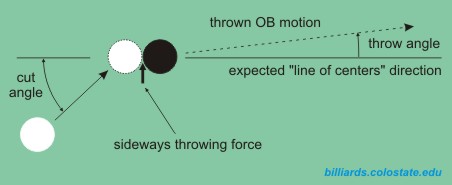It is important to understand how friction between the CB and OB can change the direction of the OB. This effect is called throw. Throw is not very large with fast speed shots, and it is less when the CB has topspin or bottom-spin, but the effect can be significant with slower-speed shots, especially with stun. When throw is due to cut angle alone, the effect is called cut-induced throw (CIT):

And when it is due to sidespin, it is called spin-induced throw (SIT):

Many important throw effects and shots are demonstrated in the following videos:
Examples of how throw can be used to your advantage can be found here: throw shot examples.
A summary of how throw varies for different types of shots can be found here: squirt, swerve, and throw effects. And answers to many common throw questions can be found here: answers to common questions about CIT and SIT.
One way to deal with throw is to eliminate it with “gearing” outside english, as covered in the following video:
Here’s a summary of the basic things you need to know about throw in your game:
- Wipe chalk marks off the CB every chance you get (before the break and with ball in hand) to prevent cling/skid/kick.
- On most shots, you can ignore throw, especially on short shots on tables with big pockets.
- To adjust your aim to compensate for CIT, aim to overcut the shot slightly (i.e., hit a little thinner, or hit a little less of the ball). If you you aim a shot full, you will likely miss it; but if you aim on the “pro side” to over-cut it slightly, it might get thrown into the heart of the pocket; and even if there is some cling/skid/kick, the ball still might go. An alternative to aiming to overcut is to use gearing outside english.
- The shots you must absolutely change your aim to compensate for throw are stun shots close to and thinner than about a 1/2-ball hit (especially at slow speed), slow roll shots, and shots with an amount of sidespin much different than the gearing outside amount of spin.
- You must adjust for throw when aiming frozen or small-gap combination shots (see the combo shot aiming resource page).
- Be aware of the maximum throw you can get with the ball conditions under which you play. Maximum throw is generally about 1 inch per foot of OB travel, or 1/2 a ball per diamond on a 9′ table, which is about 5°.
- CIT is largest for slow-speed stun shots close to a 1/2-ball hit.
- To get maximum SIT, use stun, slow speed, and about 50% of maximum sidespin (for a straight shot).
- Throw is smaller with follow and draw shots (about 1/4 with maximum backspin or full-roll topspin). Although, with a soft draw shot, much of the backspin is lost due to drag on the way to the OB which can result in a large amount of throw.
- Be aware of all squirt/swerve/throw effects so you will be able to understand and plan for a wide range of situations.
For more information, see “Everything You Need to Know About Throw” (BD, November, 2020). The System for Aiming With Sidespin (SAWS) covers in detail how to adjust for throw and CB deflection (resulting from squirt and swerve) when aiming all sorts of shots. The aim compensation when using sidespin page also contains useful resources.
Dr. Dave keeps this site commercial free, with no ads. If you appreciate the free resources, please consider making a one-time or monthly donation to show your support:
